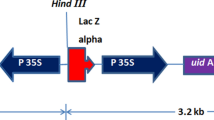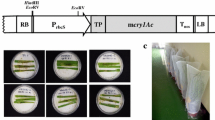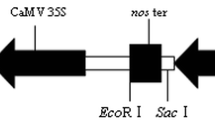Abstract
A highly efficient cowpea stable transformation system was developed with a 44 % increase in efficiency compared to the existing transformation methods by employing an improved kanamycin selection regime, and fertile transgenic plants expressing Btcry1Ac were generated. Agrobacterium-cocultivated 4-day-old cotyledonary node explants were selected on medium containing 150 mg/l kanamycin for 20 days. Surviving explants were shifted to kanamycin-free media supplemented with a reduced dosage (2.5 μM) of 6-benzyl aminopurine resulting in profuse proliferation of kanamycin-resistant shoots with a 63.6 % increase in shoot length within 15 days of culture. The elongated shoots readily developed roots on kanamycin-free rooting media and fertile plants were obtained following transfer to soil. β-glucuronidase histochemical assay, polymerase chain reaction, and reverse-transcriptase PCR analyses of T0 and T1 generations confirmed the transgenic nature of the selected plants. Of the four selection regimes tested, the established regime exhibited maximum selection efficiency (41.6 %). Analysis of T1 progeny of all the T0 transformants recovered through established selection regime showed that three-fourths had a segregation ratio of 3:1 and the remaining had a typical segregation ratio of 15:1 for segregation of Btcry1Ac. The expression of Btcry1Ac was demonstrated in T1 transgenic lines through a rapid qualitative immunodiagnostic assay and Western blot analysis. The established transformation method should provide new opportunities for the genetic improvement of cowpea for biotic and abiotic stress tolerance and nutritional quality.








Similar content being viewed by others
References
Akcay UC, Mahmoudian M, Kamci H, Yucel M, Oktem HA (2009) Agrobacterium tumefaciens-mediated genetic transformation of a recalcitrant grain legume, lentil (Lens culinaris Medik). Plant Cell Rep 28:407–417
An G, Evert PR, Mitra A, Ha SB (1988) In: Gelvin SB, Schilperoot RA (eds) Plant molecular biology manual. Kluwer, Dordrecht, pp 1–19
Bean SJ, Gooding PM, Mullineaux PM, Davies DR (1997) A simple system for pea transformation. Plant Cell Rep 16:513–519
Bradford MM (1976) A rapid and sensitive method for the quantitation of microgram quantities of protein using the principle of protein-dye binding. Anal Biochem 72:248–254
Cao MX, Huang JQ, He YL, Liu SJ, Wang CL, Jiang WZ, Wei ZM (2006) Transformation of recalcitrant turfgrass cultivars through improvement of tissue culture and selection regime. Plant Cell Tissue Org Cult 85:307–316
Chandra A, Pental D (2003) Regeneration and genetic transformation of grain legumes: an overview. Curr Sci 84:381–387
Chaudhury D, Madanpotra S, Jaiwal R, Saini R, Kumar PA, Jaiwal PK (2007) Agrobacterium tumefaciens-mediated high frequency genetic transformation of an Indian cowpea (Vigna unguiculata L. Walp.) cultivar and transmission of transgenes into progeny. Plant Sci 172:692–700
Collén AMC, Jarl CL (1999) Comparison of different methods for plant regeneration and transformation of the legume Galega orientalis Lam. (goat’s rue). Plant Cell Rep 19:13–19
Davies DR, Hamilton J, Mullineaux PM (1993) Transformation of peas. Plant Cell Rep 12:180–183
Di R, Purcell V, Collins GB, Ghabrial AS (1996) Production of transgenic soybean lines expressing the bean pod mottle virus coat protein precursor gene. Plant Cell Rep 15:746–750
Donaldson PA, Simmonds DH (2000) Susceptibility to Agrobacterium tumefaciens and cotyledonary node transformation in short season soybean. Plant Cell Rep 19:478–484
Gamborg OL, Miller RA, Ojima K (1968) Nutrient requirements of suspension cultures of soybean root cell. Exp Cell Res 50:151–158
Gulati A, Schryer O, McHughen A (2002) Production of fertile transgenic lentil (Lens culinaris Medik.) plants using particle bombardment. In Vitro Cell Dev Biol Plant 38:316–324
Hinchee MAW, Connor-Ward DV, Newell CA, Mc Donnell RE, Sato SJ, Gasser CS, Fischhoff DA, Re DB, Farley RT, Horch RB (1988) Production of transgenic soybean plants using Agrobacterium-mediated DNA transfer. Biotechnology 6:915–922
Ivo NL, Nascimento CP, Vieira LS, Campos FAP, Aragao FJL (2008) Biolistic-mediated genetic transformation of cowpea (Vigna unguiculata) and stable Mendelian inheritance of transgenes. Plant Cell Rep 27:1475–1483
Jaiwal PK, Kumari R, Ignacimuthu S, Potrykus I, Sautter C (2001) Agrobacterium tumefaciens-mediated genetic transformation of mungbean [Vigna radiata (L.) Wilczek]: a recalcitrant grain legume. Plant Sci 161:239–247
James DJ, Passey AJ, Barbara DJ, Bevan M (1989) Genetic transformation of apple (Malus pumila Mill.) using a disarmed Ti-binary vector. Plant Cell Rep 7:658–661
Jefferson RA (1987) Assaying chimeric genes in plants: the GUS gene fusion system. Plant Mol Biol 204:387–405
Jordan MC, Hobbs SLA (1993) Evaluation of a cotyledonary node regeneration system for Agrobacterium-mediated transformation of pea (Pisum sativum L). In Vitro Cell Dev Biol Plant 29:77–82
Mahmoudian M, Celikkol U, Yucel M, Oktem HA (2002a) Vaccum infiltration based Agrobacterium-mediated gene transfer to lentil (Lens culinaris) tissues. Biotech Biotechnol Equip 16:24–29
Mahmoudian M, Yucel M, Oktem HA (2002b) Transformation of lentil (Lens culinaris M.) cotyledonary nodes via vacuum infiltration of Agrobacterium tumefaciens. Plant Mol Biol Rep 20:251–257
Margam VM, Coates BS, Ba MN, Sun W, Binso-Dabire CL, Baoua I, Ishiyaku MF, Shukle JT, Hellmich RL, Covas FG, Ramasamy S, Armstrong J, Pittendrigh BR, Murdock LL (2011) Geographic distribution of phylogenetically-distinct legume pod borer, Maruca vitrata (Lepidoptera: Pyraloidea: Crambidae). Mol Biol Rep 38:893–903
Meurer CA, Dinkins RD, Collins GB (1998) Factors affecting soybean cotyledonary node transformation. Plant Cell Rep 18:180–186
Murashige T, Skoog S (1962) A revised medium for rapid growth and bioassay with tobacco tissue cultures. Physiol Plant 15:473–497
Murdock LL, Bressan RA, Sithole-Niang I, Salifu (2001) Molecular genetic improvement of cowpea for growers and consumers, NGICA Document WA5-A1. Purdue University, Network for the Genetic Improvement of the Cowpea in Africa, West Lafayette
Muthukumar B, Mariamma M, Valuthambi K, Gnanam A (1996) Genetic transformation of cotyledon explants of cowpea (Vigna unguiculata L. Walp.) using Agrobacterium tumefaciens. Plant Cell Rep 15:980–985
Obembe OO (2008) Exciting times for cowpea genetic transformation research. Life Sci J 5:50–52
Padilla IMG, Webb K, Scorza R (2003) Early antibiotic selection and efficient rooting and acclimatization improve the production of transgenic plum plants (Prunus domestica L.). Plant Cell Rep 22:38–45
Popelka JC, Gollasch S, Moore A, Molvig L, Higgins TJV (2006) Genetic transformation of cowpea (Vigna unguiculata L.) and stable transmission of the transgenes to progeny. Plant Cell Rep 25:304–312
Puonti-Kaerlas J, Eriksson T, Engström P (1990) Production of transgenic pea (Pisum sativum L.) plants by Agrobacterium tumefaciens-mediated gene transfer. Theor Appl Genet 80:246–252
Saini R, Jaiwal PK (2007) Agrobacterium tumefaciens-mediated transformation of blackgram: an assessment of factors influencing the efficiency of uidA gene transfer. Biol Plant 51:69–74
Sambrook KJ, Fritsch EF, Maniatis T (1989) Molecular cloning: a laboratory manual, 2nd edn. Cold Spring Harbor Laboratory Press, Cold Spring Harbor
Schroeder HE, Schotz AH, Wardley-Richardson T, Spencer D, Higgins TJV (1993) Transformation and regeneration of two cultivars of pea (Pisum sativum L.). Plant Physiol 101:751–757
Sharma KK, Anjaiah V (2000) An efficient method for the production of transgenic plants of peanut (Arachis hypogaea L.) through Agrobacterium tumefaciens-mediated genetic transformation. Plant Sci 159:7–19
Singh SR, Jackai LEN (1988) Screening techniques for host plant resistance to cowpea insect pests. Tropical Grain Legum Bull 35:2–18
Singh NP, Singh YI (2010) Strategy for improving the nutritional quality of grain legumes through genetic engineering. Trends Biosci 3:1–5
Solleti SK, Bakshi S, Sahoo L (2008a) Additional virulence genes in conjunction with efficient selection scheme, and compatible culture regime enhance recovery of stable transgenic plants in cowpea via Agrobacterium tumefaciens-mediated transformation. J Biotech 135:97–104
Solleti SK, Bakshi S, Purkayastha J, Panda SK, Sahoo L (2008b) Transgenic cowpea (Vigna unguiculata) seeds expressing a bean α-amylase inhibitor 1 confer resistance to storage pests, bruchid beetles. Plant Cell Rep 27:1841–1850
Somers DA, Samac DA, Olhoft PM (2003) Recent advances in legume transformation. Plant Physiol 131:892–899
Sonia SR, Singh RP, Jaiwal PK (2007) Agrobacterium tumefaciens-mediated transfer of Phaseolus vulgaris α-amylase inhibitor-1 gene into mungbean Vigna radiata (L.) Wilczek using bar as selectable marker. Plant Cell Rep 26:187–198
Tee CS, Marziah M, Tan CS, Abdullah NP (2003) Evaluation of different promoters driving the GFP reporter gene and selected target tissues for particle bombardment of Dendrobium Sonia 17. Plant Cell Rep 21:452–458
Valderrama A, Velásquez N, Rodríguez E, Zapata A, Zaidi MA, Altosaar I, Arango R (2007) Resistance to Tecia solanivora (Lepidoptera: Gelechiidae) in three transgenic Andean varieties of potato expressing Bacillus thuringiensis Cry1Ac protein. J Econ Entomol 100:172–179
Venkatachalam P, Geetha N, Jayabalan N, Saravanababu K, Sita L (1998) Agrobacterium-mediated genetic transformation of groundnut (Arachis hypogaea L.): an assessment of factors affecting regeneration of transgenic plants. J Plant Res 111:565–572
Zaidi MA, Mohammadi M, Postel S, Masson L, Altosaar I (2005) The Bt gene cry2Aa2 driven by a tissue-specific ST-LS1 promoter from potato effectively controls Heliothis virescens. Transgenic Res 14:289–298
Acknowledgments
The authors thank Prof. I. Altossar, University of Ottawa, Canada, for providing p1AcPRD; Prof. K. Veluthambi, MKU, Madurai, India, for Agrobacterium strain; and the Center for Application of Molecular Biology to International Agriculture (CAMBIA), Australia, for pCAMBIA2301. The research was supported by Grants from the Department of Biotechnology, Government of India. SB is grateful to the Council of Scientific and Industrial Research (CSIR) for a Senior Research Fellowship.
Author information
Authors and Affiliations
Corresponding author
Rights and permissions
About this article
Cite this article
Bakshi, S., Sahoo, L. How Relevant is Recalcitrance for the Recovery of Transgenic Cowpea: Implications of Selection Strategies. J Plant Growth Regul 32, 148–158 (2013). https://doi.org/10.1007/s00344-012-9284-6
Received:
Accepted:
Published:
Issue Date:
DOI: https://doi.org/10.1007/s00344-012-9284-6




